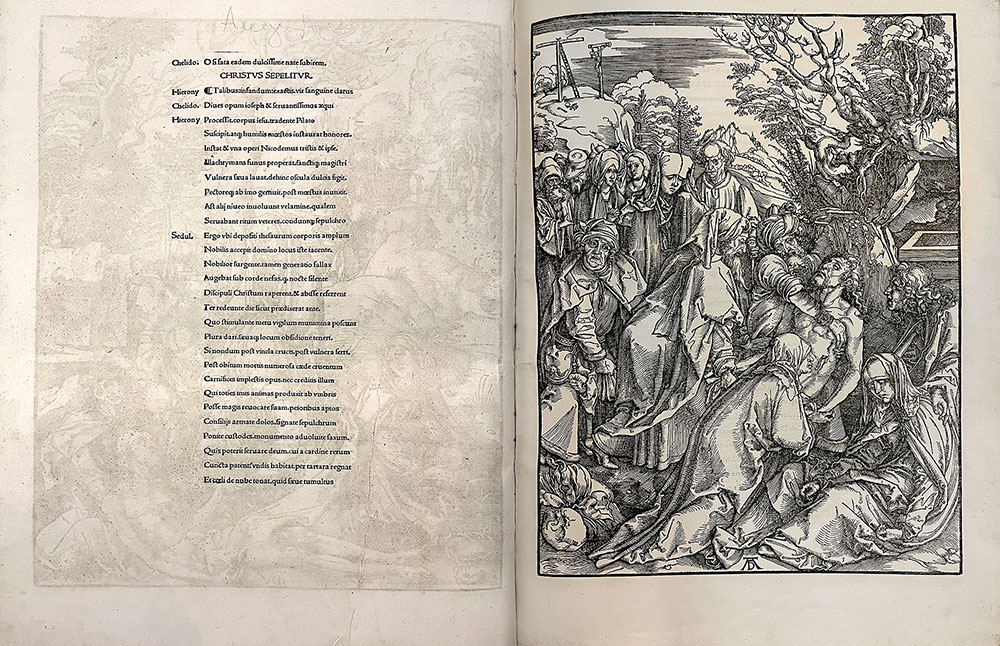
NUREMBERG: DÜRER AND HUMANISM
For Dürer, 1511 marked a period of intense engagement with commercial projects. Following on the success of his Apocalypse with Pictures, reissued that year, he produced devotional picture books designed in the same format, juxtaposing text and image on facing pages. These include the Small Passion, the Large Passion, and the Life of the Virgin—the latter two combined with the Apocalypse in this single volume, which was bound in Nuremberg and belonged to a house of pious Franciscan laywomen in Munich. With these books, Dürer created work not for a commissioning patron but for the open market. To accompany his woodcuts, he commissioned Latin poems from the humanist scholar, poet, and monk Benedict Chelidonius. Shown here, at right, is the Entombment. The tomb, however—only partly visible at the right—is tucked into the background, as is the mount of Golgotha, at upper left, whereas in the foreground, the focus remains on the mourning of Christ’s followers and disciples. The print thus both evokes a narrative continuum and invites a powerful emotional response.
Albrecht Dürer (1471–1528) and Benedict Chelidonius (ca. 1460–1521)
Passio Domini Nostri Iesu (The Large Passion), in Latin
Nuremberg: Albrecht Dürer, 1511
New York Public Library, Spencer Collection
Ger. 1511
Jeffrey Hamburger, Kuno Francke Professor of German Art & Literature, Harvard University
Albrecht Dürer’s exposure to printed books was no doubt facilitated through his godfather Anton Koberger, Germany’s most successful publisher, whose press produced the Nuremberg Chronicle among other notable works. Koberger likely had a hand in the production of the artist’s first major book project—the Apocalypse with Pictures, published in 1498 in Latin and German editions. Over a decade later, in 1511, Dürer returned to independent book projects.
Picking up on the commercial success of his Apocalypse, which he reissued that same year, he produced three more devotional picture books designed in the same novel format, juxtaposing text and full-page images across a single opening. Never before had a printed book given such prominence to pictures.
Of these books, he referred to the Large Passion, the Life of the Virgin and the reprint of the Apocalypse as his “three great books,” in reference to their large folio format. The fourth book—his Small Passion—was produced in a much smaller octavo format. With his three great books, Dürer was creating work not for a commissioning patron but rather the open market. To accompany his woodcuts, Dürer commissioned texts from the humanist scholar, poet and monk Benedict Chelidonius. Writing in a classicizing style befitting Dürer’s elite humanist audience, Chelidonius provided Horace-like odes for the Small Passion, epic verse for the Large Passion, and elegiac couplets for the Life of the Virgin.
The three great books were often sold and bound together, as in the example shown here. The value of prices is difficult to judge for this period, but generally Dürer’s three Large Books sold for a quarter Gulden each, about the cost of a nice pair of shoes. This copy’s fine leather binding, which would have been added later and at the owner’s expense, is typical of sixteenth-century Nuremberg. This copy once belonged to the important library of the St. Pütrich cloister in Munich, a house of devout Franciscan laywomen.
